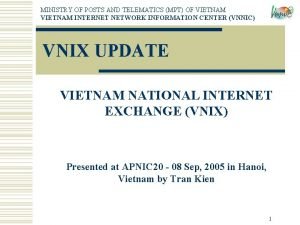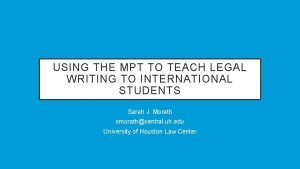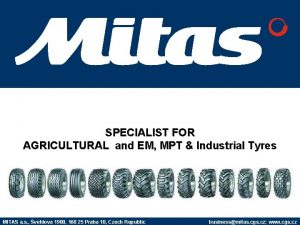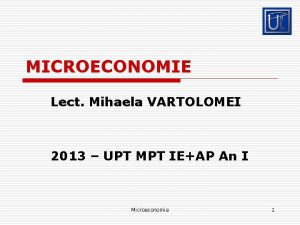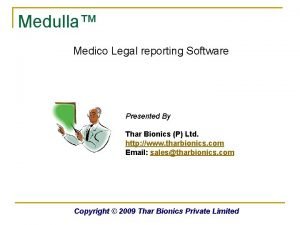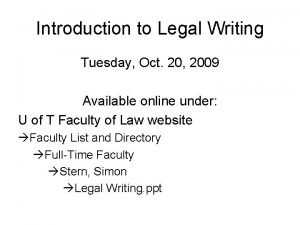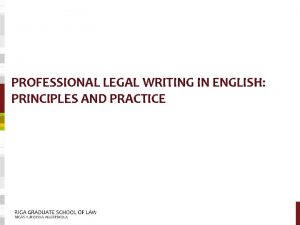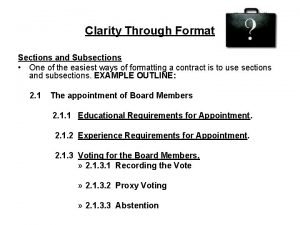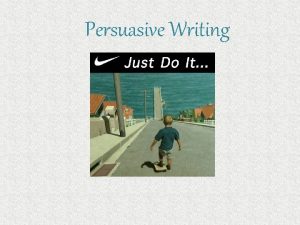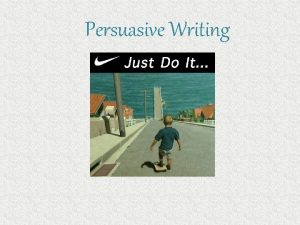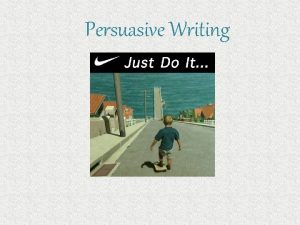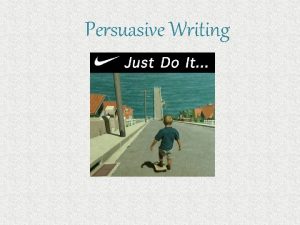USING THE MPT TO TEACH LEGAL WRITING TO
















- Slides: 16

USING THE MPT TO TEACH LEGAL WRITING TO INTERNATIONAL STUDENTS Sarah J. Morath smorath@central. uh. edu University of Houston Law Center

WHY? • All my foreign students were taking the bar exam • LSS (3 credits) is their only writing class • Don’t have the benefit of a bar review class • Taking the exam in 10 months! • This was new for everyone

CAN GRADUATES OF FOREIGN LAW SCHOOLS TAKE THE BAR EXAM?

WHAT IS THE MPT? • Multistate Performance Test • 90 minutes to complete a lawyering task • 2 MPTs = 20% of score (in UBE states) “The MPT is designed to test an examinee’s ability to use fundamental lawyering skills in a realistic situation and complete a task that a beginning lawyer should be able to accomplish. The MPT is not a test of substantive knowledge. Rather, it is designed to evaluate certain fundamental skills lawyers are expected to demonstrate regardless of the area of law in which the skills are applied. ”

MPT MATERIALS The File consists of source documents containing all the facts of the case, including the assigning memo. The File might also include transcripts of interviews, depositions, hearings or trials, pleadings, correspondence, client documents, contracts, newspaper articles, medical records, police reports, or lawyer’s notes. The Library may contain cases, statutes, regulations, or rules, some of which may not be relevant to the assigned lawyering task. Problem is set in hypothetical state of Franklin.

SKILLS TESTED The MPT requires examinees to 1. sort detailed factual materials and separate relevant from irrelevant facts; 2. analyze statutory, case, and administrative materials for applicable principles of law; 3. apply the relevant law to the relevant facts in a manner likely to resolve a client’s problem; 4. identify and resolve ethical dilemmas, when present; 5. communicate effectively in writing; and 6. complete a lawyering task within time constraints. These six fundamental lawyering skills are identified as part of the “Statement of Fundamental Lawyering Skills” from Legal Education and Professional Development: An Educational Continuum, Report of the Task Force on Law Schools and the Profession: Narrowing the Gap, known as the Mac. Crate Report (ABA 1992)

HOW IS THE MPT SCORED? A 6 answer is a very good answer. A 6 answer indicates that the applicant has a thorough comprehension of the task, the relevant factual and legal materials, and uses them to write a legally supported, well-written responsive product in the time allotted. A 5 answer is an above average answer. A 5 answer demonstrates that the applicant has a fairly complete understanding of the task, understands most of the relevant materials, and uses them to write a legally supported, reasonably well-written, mostly responsive product in the time allotted. A 4 answer is an average answer. A 4 answer indicates that an applicant has a fair understanding of the task and understands enough of the relevant materials to incorporate them into a satisfactory, though not completely responsive, product in the time allotted. A 3 answer is a somewhat below average answer. A 3 answer is inadequate. It shows that the applicant has a limited understanding of the facts, issues, and applicable principles of law and is not able to write a satisfactorily responsive product in the time allotted. A 2 answer is a below average answer. A 2 answer is significantly flawed and shows that the applicant has only a basic understanding of the task. It shows the applicant failed to grasp most of the relevant facts and law and thus has not produced a useful product in the time allotted. A 1 answer is a well below average answer. It indicates a failure to understand the task. A 1 answer shows virtually no ability to identify the relevant facts or law in the time allotted. A 0 answer is appropriate when an applicant does not write an answer at all. It is also appropriate if an answer is completely unresponsive to the question.

WHAT REALLY MATTERS 1. How closely the written products match the call of the question/the partner memo. 2. How well the student understands the law presented in the Library. 3. How well the student uses the facts presented in the File. 4. How clear and organized the requested documents are.

POTENTIAL TASKS Examinees could be asked to draft a: • memorandum to a supervising attorney; • letter to a client; • persuasive memorandum or brief; • statement of facts; • contract provision; • will; • counseling plan; • proposal for settlement or agreement; • discovery plan; • witness examination plan; or a • closing argument

EXAMPLE 1

EXAMPLE 2

EXAMPLE 3

SKILLS • Critical Reading (find the narrow assignment; recognize limitations; identify the document) • Reading Comprehension (identify the issues, facts, and holding of simplified cases) • Fact Analysis • Legal Reasoning (rule-based analogical) • Organization (CRAC or CREAC) • Format & Headings

CHALLENGES • TIME! • Unpolished product • Drafting and editing are not as important

WHY I (AND OTHERS) LIKE USING THE MPT • Exposure to an important part of the bar (low-hanging fruit) • Meeting audience expectations • Different documents with different tones (objective vs. persuasive) • Closed-universe nature limits questions about research • Citation isn’t important • Clarity and concision vs. grammar and punctuation • Benefits of timed tests • Kathleen Elliott Vinson & Sabrina De. Fabritiis, Under Pressure: How Incorporating Time. Pressured Performance Tests Prepares Students for the Bar Exam and Practice, 122 W. Va. L. Rev. ___ (2019). • “Student engagement, contextual learning, nuanced factual analysis, and early, lowstakes bar exam exposures are just some of the many “selling points” for teaching with PTs. ” • Sara J. Berman, Integrating Performance Tests into Doctrinal Courses, Skills Courses, and Institutional Benchmark Testing: A Simple Way to Enhance Student Engagement While

TIPS • Introduce a few weeks into the semester • Give students more time (3 hours) or give partial MPTs • Do more than one • Modify (most MPTs can be found online) • Stress time management • Practice reading the prompt with students (tone, format, headings) • Show students how the library matches up with the prompt • Evaluate using the 0 -6 point scale
 Mpt vietnam
Mpt vietnam Practical theology mpt
Practical theology mpt Mpt na escola
Mpt na escola Mpt persuasive brief example
Mpt persuasive brief example Mpt model
Mpt model Mpt logistics pvt ltd
Mpt logistics pvt ltd Upt mpt
Upt mpt Microeconomie definitie
Microeconomie definitie Teach the writer not the writing
Teach the writer not the writing Legal reporting software
Legal reporting software Umbrella paragraph legal writing
Umbrella paragraph legal writing Principles of legal writing
Principles of legal writing Numbering a tabulated list in legal writing
Numbering a tabulated list in legal writing Hát kết hợp bộ gõ cơ thể
Hát kết hợp bộ gõ cơ thể Bổ thể
Bổ thể Tỉ lệ cơ thể trẻ em
Tỉ lệ cơ thể trẻ em
